Culture of Jordan
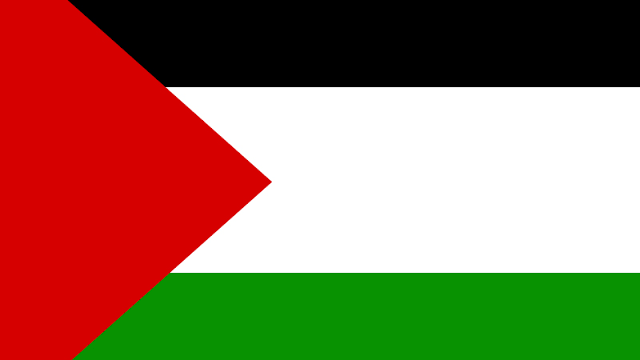
Culture Name
Jordanian
Orientation
Identification. The Emirate of Transjordan was the name given to this small state when it was recognized in 1921, after the collapse of the Ottoman Empire and the promulgation of the Balfour Declaration. It was not until 1946 that Transjordan became a completely sovereign state. In 1950, Transjordan merged with part of Palestine to form the Hashemite Kingdom of Jordan. Amman is the capital and the largest city.
Location and Geography. Jordan has an area of about 35,475 square miles (91,900 square kilometers). It lies in the center of the Middle East, sharing its northern border with Syria, eastern border with Iraq, it's southern and eastern borders with Saudi Arabia, and western border with the Jordan River, the Dead Sea, and Israel. Its only seaport is the port of Aqaba. Jordan has barren deserts, fertile valleys, and colorful rock and sand mountains. It contains the lowest point on earth, the Dead Sea, and the Great Rift Valley, which was created twenty million years ago when tectonic plates shifted, stretching from Lake Tiberius south through Jordan and into eastern Africa.
Demography. In 1946, the population was about 400,000; in 1997, it reached 4.6 million, a figure twice that of 1981. After the 1967 war with Israel and Iraq's 1990 invasion of Kuwait, there were sudden and massive influxes of Palestinian Arab refugees, who now make up more than two-thirds of the population. In 1996, 1,359,000 Palestinian refugees living in Jordan were registered with United Nations; 250,000 Palestinians continue to live in ten refugee camps. Nomadic people, predominantly Bedouin, account for more than 10 percent of the total population. The population is young, with a birthrate that is double the world average; 43 percent of the people are under age fifteen. By the year 2012, the population is expected to double.
Linguistic Affiliation. Arabic is the official language. English is taught to all students and is widely spoken.
Symbolism. The flag has black, white, and green horizontal stripes with a red triangle on the hoist side bearing a white seven-pointed star. The flag of the Palestinian people is identical but does not have the white star.
History and Ethnic Relations
Emergence of the Nation. The Nabateans built the capital of their ancient Arab kingdom, Petra, in what is now Jordan between 400 B.C.E. and 160 C.E. From Mount Nebo in western Jordan, many people believe that Moses saw the Promised Land. When the Ottoman Empire collapsed after four hundred years of rule, Britain divided up the Fertile Crescent, and modern Jordan was born.
National Identity. Jordan is the only Arab country where Palestinians can become citizens. The differentiation between Jordanians, Bedouins, and Palestinians is clear in this society. Jordanians are defined as residents who have lived east of the Jordan River since before 1948. Palestinians are defined as residents whose birthright extends back to areas west of the Jordan River. People of Bedouin descent are considered to be of the purest Arab stock.
Ethnic Relations. In deserts with little vegetation and water, Bedouin families have lived in the traditional way for thousands of years. They roam freely and pay little attention to borders. Bedouins form the core of the army, occupying key positions, even though their political influence is diminishing. Palestinians are typically referred to as educated, hard-working people, and their influence in Jordan has resulted in a greater emphasis on education and
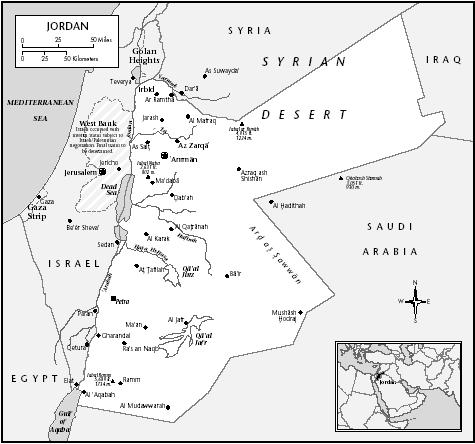
Jordan
the development of a richer, global economy. Jordanians who no longer espouse the Bedu nomad lifestyle are gradually accepting the standards of the modern Arab world.
Urbanism, Architecture, and the Use of Space
Most people live in one- or two-room apartments or houses. Affluent urban families live in larger apartments or individual homes. Buildings and homes are made of concrete, and some are made of mud and stone, with a design that allows more floors to be added, to create apartments for married sons. Privacy is very important, and many homes and other buildings open into private courtyards with concrete walls. Nomadic farmers live in tents made from the hides and fur of their animals. Amman's appearance reflects a Western influence, with modern hotels and commercial buildings. Streets are identified and numbered in an inefficient manner, and maps are hard to read and often useless.
Food and Economy
Food in Daily Life. An ancient legend tells of an Arabian shepherd who six thousand years ago put his supply of milk in a pouch made from a sheep's stomach before making a journey across the desert. The rennet in the lining of the pouch, combined with the heat of the sun, caused the milk to form curds, and cheese was discovered. Bedouin farmers keep herds of goats and sheep whose milk is used to produce cheese and yogurt. A popular cheese is called halloumi (similar to feta), made from goat or sheep milk and often served in a sandwich of pita-style bread or cubed in salads. Rice, legumes, olives, yogurt, flat breads, vegetables (cauliflower, eggplant, potatoes, okra, tomatoes, and cucumbers), lamb or chicken, and fruits (apricots, apples, bananas, melons, and oranges) form the basis for most meals. Main dishes of rice with spices are eaten almost daily. The main meal typically is served during the middle of the afternoon. A covering is placed on the floor, with a large tray of rice and meat placed in the center surrounded by small dishes of yogurt and salad. Torn pieces of bread are folded in half and used to scoop the food. The left hand is never used to feed oneself.
Food Customs at Ceremonial Occasions. When people visit family and friends, tea, Turkish-style or Arabic-style coffee, or fruit juice is served. Often this meal includes sweets, especially on holidays. The national main dish is Mansaf, which consists of lamb cooked in dried yogurt and served with seasoned rice on flat bread. Mansaf is always served on holidays and special family occasions such as visits to relatives or friends, engagements, and weddings.
Basic Economy. The economy is based on free enterprise. The service sector, consisting of government, tourism, transportation, communication, and financial services contributes the most to the economy, employing 70 percent of the workforce. Amman has developed into a regional business center.
Land Tenure and Property. Land ownership is the goal of many, but few can afford the cost. Except for the very wealthy, most people live in rented housing.
Commercial Activities. Because most of the country is desert, less than 4 percent of the land is cultivated. Natural resources are scarce, and no oil has been found. The country's archaeological sites draw more than two million visitors a year.
Major Industries. Potash, phosphate, and gypsum mining and the manufacturer of cement, fertilizers, and refined petroleum products are the largest industries.
Trade. Jordan is among the world's top three potash exporters. Since the Gulf War, the number of immigrants has increased greatly, leading to a severe trade deficit and a labor market that has not produced enough jobs.
Division of Labor. Jordan's economy is heavily impacted by its location in the Middle East, the arid landscape, its relationship with its neighbors, and its dependence on foreign aid. Its largest sectors are finance, which employs 22 percent of its labor force; transportation, which employs 16 percent; and the industrial sector, which employs 17 percent. Tourism offers the greatest prospect for development.
Social Stratification
Jordan's political and social systems are a mix of new and old, traditional and non-traditional, Bedouin and Palestinian.
Classes and Castes. All social and political systems of Jordan are centered around extended patriarchal family units based on ancestry and wealth. Family units are often led by sheikhs whose rule depends on the size of their families, their wealth, and the will of their personalities. After the death of a sheikh, the eldest son ascends to the position of head of the family.
Symbols of Social Stratification. The emerging modern Arab culture values a college education, Mercedes cars, and a home in an urban area as symbols of success. However, in traditional Arab culture, camel breeders are still considered to be highest on the social scale. Traditional clans consider anyone outside their clan to be inferior, so the tradition of only marrying a person from within their families continues.
Political Life
Government. Since 1951, Jordan has been a constitutional hereditary monarchy with a parliamentary form of government. It is politically stable, with freedom of religion, the press, and private property guaranteed. There is an ongoing program of democratization. In 1989 parliamentary elections were instituted, and since that time, martial law has been lifted and political parties have been legalized. Elections were held in 1993 and 1997.
Leadership and Political Officials. In 1999, King Hussein, the longest-serving head of state in the world, died. Hussein's oldest son, Prince Abdullah,
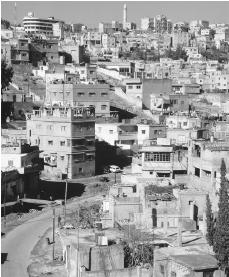
Buildings in Amman, a city that reflects western influence.
succeeded him. King Abdullah Ibn al-Hussein has indicated that he intends to follow his father's policies. He wields wide power over the government and appoints the prime minister.
Jordan's present legislative branch consists of an eighty-member elected Lower House and a forty-member Upper House. After a bill is approved by the Lower House and Senate, it is given to the King, who either grants consent by Royal Decree or returns the bill unapproved. Jordan's Constitution guarantees an independent judicial branch, dividing the courts into three categories: civil, religious, and special courts. The Jordanian civil legal system has its foundations in the Code Napoléon, a French legal code.
Social Problems and Control. Many of the country's laws are based on the Koran and the Hadith, a collection of Mohammed's sayings. These laws are enforced in religious courts called Sharia courts, which have jurisdiction over personal matters. Chastity is demanded of all single women. If a woman's chastity is compromised, a male relative may feel obligated to murder her to save the family's honor. When these cases go to court, often the charges are dropped or the murderer receives a short sentence.
Jordan has a low crime rate by international standards, with few petty crimes such as robbery reported.
Military Activity. Jordan maintains an army, an air force, and a small navy. The total strength of the armed forces in 1998 was 104,000 active members and 35,000 reserves. There is a paramilitary force that includes twenty thousand civil militia members and ten thousand public security officers. Jordan is a leader of peace efforts in the Middle East and is at peace with its neighbors.
Social Welfare and Change Programs
There is not a comprehensive welfare scheme, but the government administers medical and health services.
Nongovernmental Organizations and Other Associations
Nongovernmental organizations are involved with the environment, women, children, and economic issues. The royal family is supportive of many charitable foundations. Thirty miles north of Amman, Jerash hosts an annual summer Festival of Culture and Arts administered by the Noor Al-Hussein Foundation. The Jordanian Hashemite Fund for Human Development has social development centers throughout the country that help women and children.
Gender Roles and Statuses
Division of Labor by Gender. Most women have their lives controlled by their closest male relatives. Despite the limitations placed on them, they have made advances in education in a country where the practice of educating women only began three or four decades ago. Balancing customs and traditions at home with obedience to their husbands and the demands of a career remains a difficult challenge. When women work, they receive extensive benefits and sometimes equal pay. The 1997 census placed the proportion of women in the workforce at 14 percent, up from 8 percent in 1979. The unofficial unemployment rate for women is 65 percent.
The Relative Status of Women and Men. Sons are prized, and this status continues throughout adulthood. Most Muslim women cover their heads with scarves. A small minority cover their heads and faces with a veil. Segregation of the sexes occurs all public situations, and there is limited interaction between
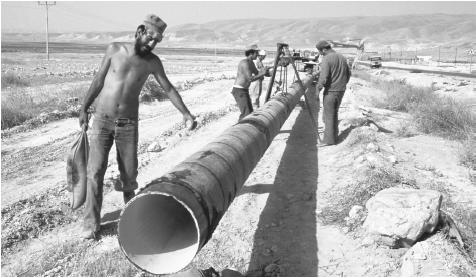
Workmen lay a water pipeline in the Jordan Valley. Most of Jordan is desert.
men and women. It is common for women to eat apart from men in restaurants. Unless they are married or related, men and women do not sit together on public transportation.
Marriage, Family, and Kinship
Marriage. Getting married and having children are top priorities. Most marriages are arranged by the father of the bride. Often cousins marry each other, and the couple may barely know each other until the engagement is announced. The wedding has two celebrations: an engagement party and a wedding party. After the engagement party, the process of dating and getting to know each other begins. After the engaged woman and man have signed the papers at the engagement party, they are legally married. If they choose not to proceed, even though they have not lived together, they must divorce. Brides must be virgins on the wedding night. After marriage, every aspect of a woman's life is dictated by her husband. She cannot obtain a passport or travel outside the country without his written approval. At any time, a husband may take another wife. Polygamy with up to four wives is legal. Divorce is legal. When there is a divorce, custody of the children automatically goes to the father, and for this reason, women choose to remain in a marriage even when there are other wives. Divorced women are viewed as outcasts.
Domestic Unit. The typical family is extended, with family size decreasing since 1979 to about six members per family. The scarcity of natural resources, especially the chronic shortage of water, makes population control vital. To slow the rapid growth rate, birth spacing programs have increased awareness of the benefits of family planning, and many wives now use contraceptives.
Inheritance. Inheritance is guided by Islamic law. A woman receives half the amount that a man receives.
Kin Groups. Kinship relationships are patriarchal. Extended family ties govern social relationships and tribal organization.
Socialization
Infant Care. Women are primary caregivers for infants and small children. After the first son is born, the father and mother take the name of the son. If the son's name is Mohammed, the father becomes Abu Mohammed, meaning "father of Mohammed," and the mother becomes Om Mohammed, or "mother of Mohammed."
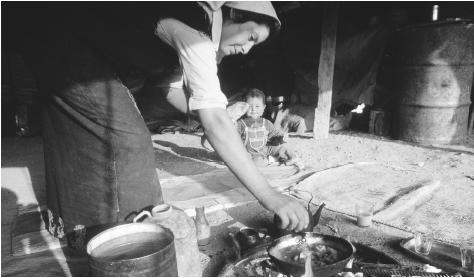
Bedouin woman preparing a meal. Free-wandering Bedouins have lived in the traditional way for thousands of years.
Child Rearing and Education. Children love to belly-dance with people watching and clapping their hands and women making a vocal expression by moving their tongues rapidly back and forth between their lips. Primary education is free and compulsory, starting at the age of six years until a child is sixteen years old. The United Nations Relief and Works Agency for Palestine Refugees provides schooling for Palestinian refugees. Outside the classroom, children participate in few activities away from the family.
Higher Education. All students are required to take an extensive examination called Tawjehieh before graduating from secondary school and as a prerequisite for entering universities and colleges. The top male and female students attend state universities and numerous private colleges. The literacy rate is over 86 percent.
Etiquette
Greetings and farewells are lengthy and sincere. Even answering a telephone involves saying "how are you?" in several different ways. Visitors and/or friends frequently are invited into homes for dinner, where they are showered with kindness and food. Women dress modestly and often are offended by exposed flesh. Most Muslims do not drink alcohol. Shoes are always removed before entering a mosque, and this custom extends to homes as well. Shib-shibs (flip-flop sandals) are always put on before entering a bathroom, the feet and are never put on a coffee table, footstool, or desk. It is forbidden and disrespectful to expose the bottoms of the feet. Same-sex friends hold hands, hug, and kiss in public, but there is limited touching between men and women. A man does not shake hands with a woman unless she offers her hand first.
Religion
Religious Beliefs. The state religion is Muslim, as indicated in the constitution. Ninety percent of the population adheres to the Sunni branch. About 6 percent of the people are Christian.
Religious Practitioners. Imams, leaders of prayer in a Muslim mosque, hold an important role in this Muslim country. In most smaller and rural communities they are the political leaders as well.
Rituals and Holy Places. Jordan has a rich religious history. For Jews and Christians, it is part of the Holy Land, sacred for its connection to the Jewish patriarchs Abraham and Moses, as well as Christian biblical figures such as John the Baptist. Jordan is equally important in the history of Islam, as many tombs of Prophet Mohammed's companions are located in Jordan. Jordan is where the non-Arab world first contacted Islam more than fifteen hundred years ago.
One of the five essential Pillars practiced by Muslims is the recitation of prayers five times a day. Calls to prayers are announced publicly by mosques and can be heard throughout the nation. The devout unroll a small prayer rug and face Mecca to pray. Ramadan, the ninth month of the Islamic calendar, is a time of fasting from sunrise until sunset. Most public restaurants do not open for business until just before sunset. Throughout Ramadan and the celebration commemorating its end, of families mark the occasion with large feasts and special sweets. Another Pillar of Islam is the Hajj, the holy pilgrimage made at least once during a lifetime to Mecca. Many pilgrims travel through Jordan on the way to Mecca in Saudi Arabia.
Medicine and Health Care
Excellent medical care is available, especially in Amman. For the typical family, finding the money to pay for medical insurance and preventive care is difficult. Life expectancy is sixty-seven years for mens and seventy years for women. Most children are fully immunized.
Secular Celebrations
Jordanians follow the Islamic calendar. National holidays include Arbor Day (15 January), Arab League Day (22 March), and Independence Day (25 May). Religious holidays include Id al-Fitr (the end of Ramadan), Id al-Adha (the Feast of the Sacrifice), the Islamic New Year, the birthday of Mohammed, and Leilat al-Meiraj (the Ascension of Mohammed).
The Arts and Humanities
Support for the Arts. In 2000, King Abdullah ordered that government workers be given Fridays and Saturdays off, hoping they would find time to develop new interests and travel to sites such as Petra. The government promotes cultural festivals, encourages the revival of handicrafts, and takes steps to preserve the country's archaeological and historical heritage.
Literature. The country's most famous poet is Mustafa Wahbi al-Tal, who is among the major Arab poets of the twentieth century. Al-Tal was a political and social activist who devoted twenty years of his life to regaining the rights of gypsies and became a member of the gypsy community.
Graphic Arts. Folk art survives in tapestries, leather crafts, pottery, and ceramics. Wool and goat hair rugs with colorful tribal designs are manufactured.
Performance Arts. Popular culture takes the form of songs, ballads, and storytelling. Villagers have special songs for births, weddings, funerals, planting, plowing, and harvesting.
The State of the Physical and Social Sciences
Since the 1960s, a number of higher learning institutions have opened in Jordan, foremost among them the University of Jordan (1962) in Amman, Yarmouk University (1976) in Irbid, and Jordanian University Science and Technology (1996) in Irbnil. These centers are recognized for their Islam, Arabic language, and Middle East peace and conflict studies.
Bibliography
Chebaro, Lina, Halawani, Bassam, and Nada Mosbah. Arabic Cooking Step by Step, 1997.
Dallas, Roland. King Hussein: A Life on the Edge, 1998.
De Blij, H. J., and Peter O. Muller. Geography: Regions and Concepts, 6th ed., 1991.
Discovery Channel. Jordan Insight Guide, 1999.
Fernea, Elizabeth Warnock. In Search of Islamic Feminism: One Woman's Global Journey, 1998.
Friedman, Thomas L. From Beirut to Jerusalem, 1995.
Goodwin, Jan. Price of Honor: Muslim Women Lift the Veil of Silence on the Islamic World, 1994.
Hussein, King of Jordan. Uneasy Lies the Head: The Autobiography of His Majesty King Hussein I of the Hashemite Kingdom of Jordan, 1962.
——. My War With Israel, 1969.
Sedlaczek, Brigitte. Petra: Art and Legend, 1997.
Shumsky, Adaia and Abraham. A Bridge across the Jordan: The Friendship between a Jewish Carpenter and the King of Jordan, 1997.
Viorst, Milton. Sandcastles: The Arabs in Search of the Modern World, 1994.
